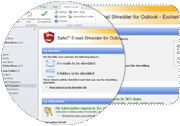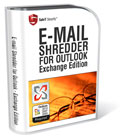Product information
E-mail Shredder for Outlook
- Exchange Edition
SafeIT E-mail Shredder for Outlook- Exchange Edition is the optimal software solution for shredding information from your client PC connected to an Exchange Server.
Selected e-mails will be shredded along with all the unused space in your Exchange Offline Storage file (OST file). This includes discarded e-mails, fragments of previously deleted e-mails and old attachments etc.
The only way to get rid of old e-mail data left behind on a client PC using Outlook is to run a shredder. The product is completely integrated in Microsoft Outlook and will enhance the way you can control your e-mail information. No configuration needs to be done on the Exchange Server. The E-mail Shredder- Exchange Edition also supports shredding in the archived PST files to give the user full security.
 Download 30 day demo (PST version)
Download 30 day demo (PST version)
 Get quote for organizational licensing >>
Get quote for organizational licensing >>
Main Features

- Supports shredding of both OST files and PST files for Outlook Exchange PC clients with offline storage.
- Quickly and easily select an e-mail to be shredded by moving it into the shredder folder added by the program.
- Keep track of how much you use the software with easy to read statistics of how much data that has been shredded.
- Shred both selected e-mail and all the unused space of your PST-file (includes discarded e-mails, fragments of previously deleted e-mails and old attachments).
- Schedule shreddings to make sure your daily communication is kept secure with nothing left behind that you want to have erased.
- Completely integrated in Microsoft Outlook, easy to install and use.
Deleted E-mails are NOT removed, only hidden
When you use Microsoft Outlook your e-mails are automatically and consistently duplicated, left behind and hidden away. An e-mail can exist up to eight times in your PST- or OST-file and traces of old discarded e-mails can exist from the time you first created your Outlook file.
In Microsoft Outlook; when you delete an e-mail, empty the “Deleted Items” folder, or even compress the PST-file or archive your OST-file, the information is NOT removed from your computer. These commands only alter the structure of the storage files, leaving most of the data intact and recoverable with software tools easily available. This means that someone else can recreate old e-mails that you thought you have already deleted.
How is an e-mail shredded?
E-mails are shredded by overwriting its content a number of times with pre-defined data patterns. This will make recovery impossible, even with advanced software and hardware analysis tools. SafeIT E-mail Shredder currently supports 13 different algorithms ranging from 1 run up to 35 runs. Use the algorithm that your company's policy dictates or the one you are most comfortable with.
Because Microsoft Outlook creates multiple duplicates of a single e-mail simply shredding the selected e-mail is not enough. Therefore, when you select a single e-mail, all the unused space of your PST-file or OST-file will be shredded. This is done to ensure that every trace of the e-mail is permanently removed - even the small fragments that are commonly scattered all through the storage files.
Things you didn’t know about security in Microsoft Outlook!
An e-mail can exist up to eight different times in your storage
file. (Even more if you move it between folders.)
Whenever an e-mail is moved into the Deleted Items-folder, it will actually get copied to a new location in the storage file, rather than deleted. (Contributing to the problem mentioned above.)
Commonly between 20-50 % of a typical storage file is unused space (potentially containing sensitive information).
The option “Compressible encryption” when creating a PST- or OST-file is the simplest form of encryption and only transposes the data (Ceasar cipher style). This is very easy to remove.
The option “High encryption” when creating a PST- or OST-file only improves security slightly but contains several weaknesses that makes it vulnerable to attack. It is, for example, still possible to change the password (see above) of the file and access the information that way.
The SafeIT Shredding Technology is based on well known standards and approved algorithms for complete data removal. The program has support for the following overwriting algorithm:
- HMG Infosec Standard 5, The Baseline Standard
- HMG Infosec Standard 5, The Enhanced Standard
- Peter Gutmann's algorithm
- U.S.Department of Defense Sanitizing (DOD 5220.22-M)
- Bruce Schneier's algorithm
- Navy Staff Office Publication (NAVSO P-5239-26) for RLL
- The National Computer Security Center(NCSC-TG-025)
- Air Force System Security Instruction 5020 (AFSSI-5020)
- US Army AR380-19
- German Standard VSITR
- OPNAVINST 5239.1A
- National Security Agency (NSA/CSS Manual 130-1) – for magnetic storage only.
- U.S.Department of Defense Sanitizing (DoD 5220.22-M ECE)
System requirements Languages

- Microsoft Windows 8, 7, Vista, or XP.
- Microsoft Office Outlook 2013, 2010, 2007 and 2003.
- Exchange 2003 and 2007 using offline storage with OST files on the client.
- Outlook Personal Storage file using the PST2003 format.
- English
- German
- Swedish
- French
- Chinese






